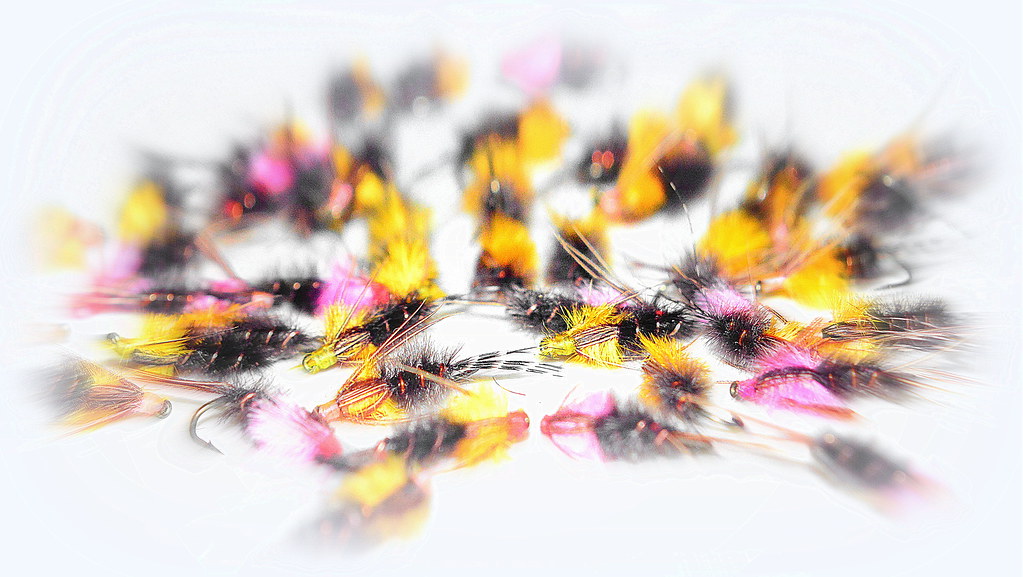NO BIG SECRET
Colors Come And Go
must be the material
 |
| ORIGINAL FEATHER DUSTER |
-------
.. George Edward Mackenzie Skues has a Facebook Page, HERE. It's worth a look. So is fishing with a fly that can't be seen... Although genteel conversations today reflect the controversy that erupted on the chalk streams of England over a century ago, there is a growing schism in the mindset of some fly fishers, (for a precis of the man and the controversy check THIS, OR THIS.) [[Should you need a copy of the book there is one for sale at AMAZON.]]
 |
| WHITE THORAX FEATHER DUSTER |
.. Most often, in the life of a trout, the fish is in the depths of the water. They forage and nibble and gulp up food where it is most reliably present. Most often that's where we place our flies.
.. During this time in the early season we are partial to a local invention: the Feather Duster. We go through a hundred or so of these flies each year. We fish them where the fish are: down deep and in the snarls of weeds, twigs, logs, boulders, etc. They catch a lot of fish and more other stuff.
 |
| PINK AND YELLOW FEATHER DUSTERS |
.. It probably has as much to do with the fly as with how we fish it - perhaps more. It might even have to do with the fact that we fish the fly more often than others.
.. Color variations and bead heads have cropped up over the years. They all work eventually.
.. Lately we've had our head stuck on a couple of colors: pink and yellow. There does not seem to be, to our feeble mind, much difference in the effectiveness of either color. Obviously we'll need more research in this area. More twigs, snarls, weeds and rocks are in our future.
.. Right now we're fishing the yellow. We've just finished with the pink ones, for the moment. Soon we'll be using up our stash of originals. The merry go round never ceases.
.. Some of our local feather merchants carry Feather Duster flies. Some shops have given them up for their own latest and greatest creations.
.. The interesting thing about different fly varieties is that they all work and they all are gobbled up by visitors seeking something special.
.. We've run out of money for the latest and greatest.
-------
 |
| WALLPAPER: YELLOW THORAX FEATHER DUSTER |
-------
.. This old fly gained surprising popularity soon after Bob Bates described
it in the Outdoor Press, (August 26, 1993). It was developed in the
early 70's and has garnered a following of dedicated nymph fishermen. The original article is hard to find, so we have reproduced it here.
***
"WALLY'S FEATHER DUSTER"
.. Eagle's Store in West Yellowstone, MT is just a block and a half from [the] Yellowstone National park west entrance. They stock a lot of things that you need but can't find in the gift-shop-type stores around West Yellowstone. As always it was the fly shop section that interested me most. Beside a normal collection of fishing paraphernalia and good information, they had a set of pictures showing how to build a Feather Duster... The name was bestowed because Wally Eagle, who developed it in the early 70's, used ostrich herl from a feather duster for early copies. (Please do not confuse it with similarly named flies, such as the English dry pattern.) Wally's Feather Duster catches a lot of fish around West Yellowstone and should prove equally successful elsewhere in our northwestern region. Wally provided additional tying details and fishing techniques and a sample fly to photograph.
.. Wally recommends fishing it dead drift with a yarn strike indicator. Any strange movement of the indicator might mean a strike so tighten up a little. You'll know instantly if it is a fish or the bottom. To place an indicator, simply tie an overhand knot in the leader and put a piece of yarn inside the loop. Carry a safety pin to open the knot and change it's position.
.. For fishing the Madison River, place your indicator about 3 - 4 feet above the fly and add a split shot, if needed. On spring creeks, place a sheep's wool indicator only 18 - 20 inches above the fly. The sheep's wool indicator should be as small as possible. Wally uses a chartreuse indicator for good light conditions, but finds it hard to see in some conditions. He recommends using pink or green indicators in bad light conditions.
-- Hook: Mustad 9672, 10 - 18
-- Thread: Burnt orange 3.0
-- Weight: Lead wire
-- Under body: Gray wool
-- Tail: Pheasant tail fibers
-- Rib: Copper wire
-- Body and thorax: Ostrich herl, dark gray
-- Wing case: Pheasant tail fibers
.. Put about five wraps of lead wire around the shank where the thorax will be. Just keep it back from the eye three or four eye widths, so you will have plenty of room for other materials. Use a lead wire that is about equal to the hook wire diameter. Attach your tying thread and wrap over the the lead a couple of times to secure it. Bring the tying thread rearward and attach a strand of wool. Wrap the wool to make an under body for the ostrich herl and shape the thorax; the wool also makes a soft base for the pheasant tail fibers. As with the lead wire, leave plenty of room for a head. .
. Use 6 or so pheasant tail fibers for the tail, attach them at the bend and make the tail about a gap width long. Also just in front of the bend secure a copper wire and 5 or 6 ostrich herls. Attach the herls by the tips if you want to taper the body and by the butts if you want a full body. Carry herls forward to mid shank or 2/5ths point depending on if you want a longer or shorter thorax, secure and trim. Counter wind copper wire ribbing, secure and trim.
.. Then right in front of body, tie in 8 to 10 pheasant tail fibers with the butts forward. Leave about a shank length of tips facing rearward. Wrap over butts, bring thread back to tie in point, fold butts back and secure. Attach several ostrich herls for thorax, wrap thread forward, wrap herls forward, secure and trim. Be sure to leave plenty of space for the head. Bring pheasant tail butts forward. secure and trim. Pull tips forward, secure with one or two thread wraps and bend tips back on each side for legs. Legs should extend along the body, ending short of the point. If there are too many legs just trim off a few. Finish the head with a whip finish. Wally doesn't use thread cement because he feels that it lets the Turle knot slip.
.. Pheasant tail is fairly delicate and breaks when big fish chew on it. Extra layers on Wally's Feather Duster wing case give you the opportunity to clip off broken fibers and still have a neat looking wing case. .. Note: on flies 16 and smaller, Wally's tiers might use partridge instead of pheasant tail for tail, wing case, and legs.

.jpg)



.jpg)






